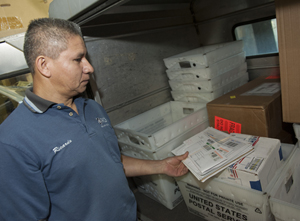Delivery Services keeps mail moving on campus
It happens every December. Regardless of the weather, Delivery Services braces for a blizzard — this one in the form of mail. When the university closes down for winter recess, the facility on the southwest side of campus becomes buried in an avalanche of envelopes, magazines, boxes and other packages.
Stuff that cannot be dropped off at academic buildings and residential colleges gets delivered to Delivery Services. And the usual intake of daily mail and packages accumulates since these items can’t be delivered either. By Jan. 2, the mail room is stuffed like a holiday glutton.
To keep ahead of the snowball effect, members of the Delivery Services team work for four hours every day during the break — except for Dec. 25 and Jan. 1 — to ensure that Rice’s mail service will hum along like a well-oiled machine when the university reopens.
“It’s really so we can keep up with it,” said Ute Franklin, manager of Delivery Services. “Otherwise it would be total chaos when we get back. It would take us a week just to catch up with the backlog.”
As it is, it takes two days after the university reopens to deliver everything that comes in over the recess. Not only are they delivering the accumulated items that were not able to be delivered to campus locations closed during the recess, but also additional items Delivery Services does not normally intake — UPS packages, mail for students and masters that usually is delivered directly to the colleges and deliveries for bookstore and Fondren Library.
In the first four days after the recess, Delivery Services scanned in almost 1,200 items — and that number doesn’t include regular mail, which doesn’t have tracking numbers.
This isn’t anything new to Franklin, who has worked in Delivery Services for about 14 years, or to the 10 other employees in Delivery Services. They’ve been handling the winter recess this way for years.

Delivery Specialist Ricardo Cruz loads his cart with mail and packages for the morning delivery. Photo by Jeff Fitlow.
Do they dread the holidays? “Yeah, we do,” she laughed. “It’s just total chaos — packages are everywhere. And then people come in or call looking for packages.”
That’s when Franklin turns into a detective, which she does quite a lot.
“Everybody calls me when they’re looking for something from UPS because I know who to contact, the couriers’ names, phone numbers,” she said. “I can always track it somehow.”
Then there are items sent to just “Rice University” — no name or department information — that she must figure out how to route.
Franklin said if it’s obviously an invoice, it gets sent to Payment Solutions. If it’s a check, it’s sent to the Cashier’s Office. If it’s from a student or a high school, it goes to the Office of Admission.
“Otherwise, if we can’t recognize the contents, I open it and decide where it should go,” she said.
Sometimes it requires a phone call to the Procurement Office to match a purchase order number with the person or department that ordered the package.
The strangest thing Franklin’s received? Several thousand dollars in money orders. The envelopes were all marked “return to sender,” with Rice’s post office box as the return address. She did some sleuthing and found the addressee was not at the delivery address, nor was the addressee name affiliated with Rice.
“It happened over several days and (her colleagues at) other universities received the same things,” she said. She contacted the postal inspector, who took over the case, but she never learned what the outcome was.
“There’s never a boring day,” she said. “There’s always tons of stuff to do — and always something different.”
The daily process, however, is usually the same:
At 6:30 a.m., two employees go downtown to pick up the mail from Rice’s post office box. When they get back, a little after 7, the rest of the staff is getting in, and they all pitch in to sort the mail from the P.O. box. The delivery people bundle their mail and put it in the order that they walk their routes.
FedEx arrives, and those deliveries get sorted by the five campus routes — four on-campus, one to the off-campus locations – and then they are scanned and placed in the delivery carts.
Five delivery specialists depart around 9:30 for appointed rounds on Rice’s 235 mail stops.
When they return to the mail facility around 11 a.m., they drop off outgoing mail that needs to be metered in the metering area and distribute interdepartmental mail in the sorting area. After a lunch break, they receive and sort the mail that was sent to Rice’s street address, bundle it with campus mail that was picked up in the morning and go back out for the afternoon delivery.
And they do it all over again the next day.
From year to year it remains pretty much the same, except for two things: the volume of mail and the postal fees and rules.
In 2013, Delivery Services scanned in nearly 33,000 letters and packages, almost a 15 percent increase over the amount scanned in 2012. The amount of campus mail has remained pretty steady at about 1,500 pieces. And the amount of incoming and outgoing pieces of mail averages about 4,000, which is down over the past four or five years, Franklin said.
The other thing that is always changing is postal service rules, mailing specifications and fees. For example, the price of a stamp increased by 3 cents this month.
Fortunately for Rice, Franklin and the staff of Delivery Services stay abreast of such changes. However, Franklin wishes more people on campus would tap into her knowledge, especially when they’re developing brochures or other items to be mailed.
Many people rely on the printer or designer to know the best layout sizes to get the best bang for the buck, but that’s not always so, Franklin said.
“The mail piece might be just a quarter of an inch too large, so then it’s a ‘flat’ instead of a letter, and the price (of mailing the item) shoots up,” she said.
Many departments do know to check with her. The designers in Public Affairs’ Creative Services, for instance, know to consult her when they have a question, and she keeps them updated as well on postal specification changes.
Franklin will be sharing her knowledge soon in training classes that she will teach Feb. 4 and 6 from 9 to 11 a.m. in the Rice Police Department’s training room. She’ll be discussing the basics of mailing, formatting a piece of mail, bulk mailing, business reply mail and more. For information on the classes or to sign up, contact Franklin at umf@rice.edu.



Leave a Reply